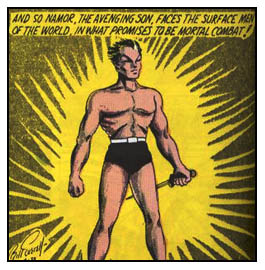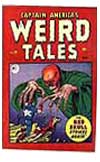| When
Marvel Was Timely, Part II: The Big Three
(first published Winter 1998 issue
of Once Upon A Dime)
The king of Atlantis. A robot who could burst into
flames. And America’s first super-soldier.
The Sub-Mariner, the Human Torch and Captain America
were by far the most popular heroes to emerge from
Timely Comics in the 1940s. Timely, which would
in the 1960s become known as Marvel Comics, was
a second-tier publisher during World War II. Their
line consisted of a number of second-rate characters,
as mentioned in my earlier article “Timely
Seconds”; only the big three characters
really captured the imagination of the comics fans
of the era. The big three Timely characters were
unique and exciting creations, graced with art that
was generally better than what was normal in the
era, and full of vibrant action.
 No
character better exemplified the dynamic style of
1940s Marvel than Captain America. As originally
drawn by the legendary team of Joe Simon and Jack
Kirby, Cap and his young partner Bucky fought endless
battles against Nazi saboteurs and the evil Red
Skull. Captain America’s origin is well-known
by most comics fans. Milquetoast Steve Rogers, too
scrawny and weak to join the military in the days
before World War II, volunteers to be bombarded
by the mysterious vita-rays and be transformed into
America’s first super soldier. Immediately
after getting his vita-ray treatment, Rogers sees
their inventor, Dr. Reinstein, killed by a Nazi
spy. Avenging Reinstein’s death by throwing
the spy onto the exploding vita-ray generator, Rogers
dons the star-spangled uniform of Captain America
in order to fight the Nazi evil wherever it may
rise. Soon Rogers is inducted into the Army, where
the young camp mascot Bucky Barnes discovers his
identity. Those being more innocent times, Cap enlists
Bucky as his fighting partner, who would fight at
Cap’s side against endless groups of Nazis
and the evil Red Skull. No
character better exemplified the dynamic style of
1940s Marvel than Captain America. As originally
drawn by the legendary team of Joe Simon and Jack
Kirby, Cap and his young partner Bucky fought endless
battles against Nazi saboteurs and the evil Red
Skull. Captain America’s origin is well-known
by most comics fans. Milquetoast Steve Rogers, too
scrawny and weak to join the military in the days
before World War II, volunteers to be bombarded
by the mysterious vita-rays and be transformed into
America’s first super soldier. Immediately
after getting his vita-ray treatment, Rogers sees
their inventor, Dr. Reinstein, killed by a Nazi
spy. Avenging Reinstein’s death by throwing
the spy onto the exploding vita-ray generator, Rogers
dons the star-spangled uniform of Captain America
in order to fight the Nazi evil wherever it may
rise. Soon Rogers is inducted into the Army, where
the young camp mascot Bucky Barnes discovers his
identity. Those being more innocent times, Cap enlists
Bucky as his fighting partner, who would fight at
Cap’s side against endless groups of Nazis
and the evil Red Skull.
The Skull, of course, would end up being Cap’s
greatest enemy after his revival in the 1960s, but
his earliest appearances were the spookiest. Simon
and Kirby depicted the Skull as a malevolent glowing
beet-red spirit of Nazi evil. Always playing Chopin’s
Funeral March as he attacked the forces of good,
the Red Skull was seemingly intelligent and comprehensive
in his plans, making the character seem far more
evil than he would under his Silver Age creators.
Cap and Bucky were perhaps the most popular of
all the many great creations of the Simon &
Kirby team in the Golden Age and it’s easy
to see why. Kirby’s art has long been synonymous
with action and excitement, and in the adventures
of Cap, Kirby may have hit his Golden Age apex.
Action seemed to explode out of every panel.
 Equally
as memorable as Cap and Bucky was the mysterious
Namor, the Sub-Mariner, king of Atlantis. As created
and sumptuously drawn by Bill Everett, Namor was
unique among other "heroes" of the time.
He was regal and imperious, an avenging spirit seeking
vengeance against the evils done to Atlantis by
the dwellers on the surface world. In his earliest
appearances, the Sub-Mariner was a marauding super-human
spirit of vengeance, loosing his anger at New York
City and other large American cities. Equally
as memorable as Cap and Bucky was the mysterious
Namor, the Sub-Mariner, king of Atlantis. As created
and sumptuously drawn by Bill Everett, Namor was
unique among other "heroes" of the time.
He was regal and imperious, an avenging spirit seeking
vengeance against the evils done to Atlantis by
the dwellers on the surface world. In his earliest
appearances, the Sub-Mariner was a marauding super-human
spirit of vengeance, loosing his anger at New York
City and other large American cities.
As the Second World War approached, Namor changed
to the side of the Allies. Most of his stories from
that era depicted the Sub-Mariner battling the Nazi
menace.
Everett’s art was some of the finest of any
artist in the Golden Age. His angular linework and
lively rendering helped make the Sub-Mariner into
one of the most exotic of all the Golden Age heroes.
Few artists have been as successful as Everett at
depicting undersea scenes – the setting really
comes alive under his penciling.
 The
final of the big three is the Human Torch. Ironically,
the Torch isn’t actually a human, but is actually
a robot (or “a synthetic man” as he’s
described in his first appearance) created by the
genius Professor Horton. The robot is perfect in
every way, except for one flaw: when exposed to
the air, it bursts into flame. When this fearsome
flaw is discovered, it’s decided to encase
the Torch in a steel tube and bury him in the ground.
That works until an explosion happens near the tube
and the Torch escapes, inadvertently creating a
trail of terror. Finally, he encounters a gangster
and defeats him, in the progress of the battle learning
how to control his flame. Almost more the script
of a horror movie than the template for an action
hero, it’s a unique and interesting origin.
Later on the Torch would take on a civilian identity
with the New York Police Department. He would also
bring in his own teen companion, Thomas Raymond,
or “Toro,” who was a former circus performer
who also was able to burst into flame and fight
evil-doers. The
final of the big three is the Human Torch. Ironically,
the Torch isn’t actually a human, but is actually
a robot (or “a synthetic man” as he’s
described in his first appearance) created by the
genius Professor Horton. The robot is perfect in
every way, except for one flaw: when exposed to
the air, it bursts into flame. When this fearsome
flaw is discovered, it’s decided to encase
the Torch in a steel tube and bury him in the ground.
That works until an explosion happens near the tube
and the Torch escapes, inadvertently creating a
trail of terror. Finally, he encounters a gangster
and defeats him, in the progress of the battle learning
how to control his flame. Almost more the script
of a horror movie than the template for an action
hero, it’s a unique and interesting origin.
Later on the Torch would take on a civilian identity
with the New York Police Department. He would also
bring in his own teen companion, Thomas Raymond,
or “Toro,” who was a former circus performer
who also was able to burst into flame and fight
evil-doers.
Artist Carl Burgos was nowhere near the level of
Everett or Simon and Kirby. The first Human Torch
story in Marvel Comics #1, in fact, contains strikingly
amateurish artwork. But Burgos improved over the
years and eventually became quite competent at depicting
action scenes. Besides, the visual of a man on fire
fighting crime or Nazis was always an exciting image.
Perhaps the best-remembered Timely Golden Age books
are the epic battles fought between the Torch and
the Sub-Mariner. It’s only natural that heroes
representing fire and water would find themselves
at odds with each other, especially since one was
a policeman and the other the king of an empire
dedicated to destroying the surface world. Their
conflicts consumed many pages of Marvel Mystery
Comics, with fights in zoos, on skyscrapers and
on the Brooklyn Bridge. But soon, a new menace would
come to appear, a menace that would cause the men
to become friends and allies: the Nazis.
It’s hard to overestimate the extent of the
Nazi menace in Timely Comics during the War. The
Nazis, and to a somewhat lesser extent the Japanese,
were the adversaries of Cap, the Torch and Namor
from the days before Pearl Harbor to the period
immediately after the war. The three were constantly
uncovering evil plots to destroy the American way
of life, endlessly fighting bizarre menaces in order
to defend America.
 After
the war, super-heroes began fading. Westerns, romances,
crime and horror comics began to move to the forefront.
The stories of the big three became more and more
lackluster as top talent devoted its talent elsewhere.
By 1950 all three characters had faded into obscurity.
Cap even saw his solo comic renamed Captain America’s
Weird Tales before it was cancelled in 1950. Except
for an ill-fated and short-lived revival of the
three characters in 1954, all three faded away until
super-heroes re-emerged at Marvel in the 1960s. After
the war, super-heroes began fading. Westerns, romances,
crime and horror comics began to move to the forefront.
The stories of the big three became more and more
lackluster as top talent devoted its talent elsewhere.
By 1950 all three characters had faded into obscurity.
Cap even saw his solo comic renamed Captain America’s
Weird Tales before it was cancelled in 1950. Except
for an ill-fated and short-lived revival of the
three characters in 1954, all three faded away until
super-heroes re-emerged at Marvel in the 1960s.
When they were good, they were outstanding, but
when they were bad they could be pretty awful. Timely
Comics featured some great art and story by the
likes of Joe Simon and Jack Kirby, Bill Everett,
John Romita, Russ Heath, Mike Sekowsky, Mickey Spillane,
Stan Lee and many others. They also featured the
work of hundreds of journeyman cartoonists and writers
who did dull, uninspired work. Still, even if there
had never been a Marvel Comics in the 1960s, the
Timely books will still be worth reading. They represent
a long-lost era.
--Jason
Sacks

For more articles by Jason Sacks,
check out his personal
web site.
|